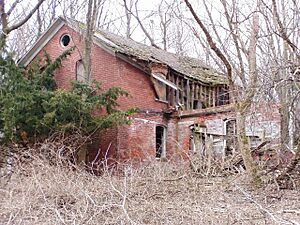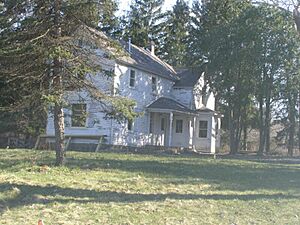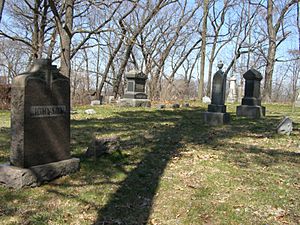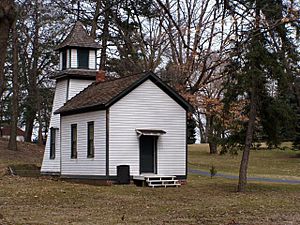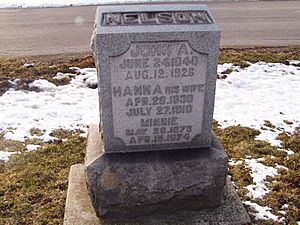Swedish Farmsteads of Porter County, Indiana facts for kids
The Swedish American Farmsteads in Porter County, Indiana are special places. They show us how many Swedish families built new lives in America. These farms were important centers for their religious and social lives. They are some of the best examples of Swedish communities from the early 1900s in the Baileytown area.
Contents
Swedish People Come to Indiana
Swedish people came to Indiana mostly because it was close to Chicago. From 1840 to 1920, many Swedes moved to America. They came because there were too many people and not enough land in Sweden. Coming to America offered new chances, which were sometimes made to sound even better in letters sent home.
Most of the people who came were from the middle class. Traveling to America cost a lot of money, so only those who were better off could afford the trip. Families who were worried about losing their jobs or social standing would take the risk to come to America. Before 1860, some people who disagreed with the main church also moved to America, but this was not a big reason for most.
Many Swedish immigrants wanted to settle in the western prairies where there was lots of land. Because of this, Chicago became a main city for Swedish life in America. By 1920, Chicago had Swedish newspapers and art groups. When a railroad was built through the area in 1850, it made it easier for immigrants to reach northern Indiana.
There's a story that a man named Jonas Asp asked Swedes to come work for Joel Wicker. They cut lumber to send to Chicago. Another story says that after the Great Chicago Fire in 1871, some Swedish families moved east from Chicago. They came to an already existing Swedish community. By the late 1800s, a large Swedish community lived along the Little Calumet River.
About 30 members of the Swedes Lutheran Church settled Bailly Town in 1857. They were connected to the 'Bethel' Swedish Community in Miller Beach. In 1863, they built their first church. After the Chicago Fire in 1871, even more families arrived.
Community life often happened around the Augsburg Evangelical Lutheran Church in Porter. Later, in the mid-1800s, the church group split. Some members then started the Bethlehem Lutheran Church in Chesterton.
Anders Kjellberg Farm
The Chellberg Farm is important because it shows the history of this Swedish American settlement. Other Swedish places nearby, like the Burstrom Chapel and Cemetery, have also been saved. The farm includes the family house, a water house with a windmill, a chicken coop (which was also a bunkhouse), and the original barn.
John Borg Farm
The John Borg Farm was also known as the Clara Samuelson Farm.
John Borg bought this land and started farming on September 4, 1888. The soil wasn't very good for growing crops, so he quickly started raising animals instead. Today, there are no big buildings left from the farm. The farm was originally about 20 acres (8.1 ha) and later grew to reach the Little Calumet River. All the land was once farmed, but now it has grown back into a young forest with silver maple and elm trees. In one corner, along Oak Hill Road, was the farm's original water drainage area. Today, it is a wetland forest. The building of U.S. 20 greatly changed the property.
John Borg Farm Structures
- The main house was a two-story building with a special "gabled-Ell" shape and brick on the outside. The inside layout was a mirror image of the Anders Chellberg main house. A local architect named A.J. Lundquist designed it.
- The barn, silo, and other farm buildings have disappeared over time.
Charles Johnson Farm
Charles Johnson bought about 6.78 acres (2.74 ha) from Charles Anderson. Mr. Anderson had been living in a log cabin on the land since about 1880. When Johnson bought the property in 1904, the cabin was the only building there, along with an apple orchard. One of the Johnsons' daughters often went to this farm to buy apples. One day, Mr. Anderson offered to give her the apple tree. She really wanted her parents to move it, but that wasn't possible. So, Mr. Johnson asked if he could buy the property. Mr. Anderson said he would sell if the Johnsons built him a new place in the woods to live out his life.
Pete Larsen Farm
F. Burstrom bought this land from the Bailly Homestead in the early 1870s. Peter Larson, a Swedish immigrant, was a successful carpenter from Chicago. He was a construction manager and didn't spend much time at the farm, only coming home on weekends. He was wealthier than many other farmers. He bought a house from a Sears catalogue and hired help to build it.
Sugar Bush Farm
The Sugar Bush Farm was also known as the Charles P. Nelson Farm.
The Charles P. Nelson Farm is an important part of the planned Swedish Farmstead Historic District. The farmhouse is still standing at 891 N. Mineral Springs Road, Porter, Indiana. In 2010, it was a private home built in 1891. It has the traditional "gabled Ell" design. The National Park Service owns the land and the building.
In 1876, the property was recorded as belonging to E. Allenquist. By 1895, C.P. Nelson and John Nelson owned this 80 acres (320,000 m2) farm together. By 1906, C.P. Nelson was the only owner. By 1921, Matilda Nelson was listed as the owner, with C.W. Nelson living there. This is also the first time the name 'Sugar Bush Farm' was used.
Sugar Bush Farm Structures
- Farm House
Gustaf Lindstrom Farm
The Lindstrom/Wahl farm was started by Swedish immigrant Gustaf Lindstrom in 1870. It is located south of Baileytown. Before 1900, Arthur Wahl bought the property and built most of the buildings that are there today. This farm shows how successful some of the early Swedish settlers became. The house was first a two-room log cabin. As the family became wealthier, a larger house was built around the log cabin, and a barn was added. This happened after 1900. Like other Swedish farmers, the Wahls also had jobs outside the farm to earn money. They continued to farm and started a plant nursery in the 1930s.
Other Important Places
Outside the National Lakeshore, there are other historic buildings connected to the Swedish Farmstead Historic District, but they are not included in it.
Burstrom Cemetery
This cemetery is on E. Oak Hill Road in Porter, Indiana, north of the Swedish Skola. It was started in 1870 and is still privately owned.
Augsberg Swensk Skola
The Augsberg Swensk Skola was first built in 1880, with more work done in 1934. Swedish immigrants from the 1800s built this school. Its design shows church building styles from Sweden. The bell tower is not in the center, which was common in Sweden. Unlike in Sweden, the bell tower here has been closed in, and the room created below it is used for tools and wood storage. The building's design comes from a traditional style that is very old, dating back to the Middle Ages.
The Augsberg Swensk Skola is an important part of the planned Swedish Farmstead Historic District. It is on East Oak Hill Road in Porter, Indiana. The school and church were built in 1880. It has one room and a gabled front.
Westchester Township School District No. 4
Westchester Township School District No. 4 is an important part of the planned Swedish Farmstead Historic District. It is privately owned and located at the corner of Waverly Road and Oak Hill Road in Porter, Indiana. This was the first school house to serve the Swedish community. It was built in 1881. It is shaped like a rectangle with a gabled front.
Augsburg Cemetery
Augsburg Cemetery (started in 1878) is an important part of a Swedish Farmstead Historic District. Many of the first Swedish families from the area are buried here. The cemetery is south of Augsburg Lutheran Church on Beam Road in Porter, Indiana.
Bethlehem Lutheran Church
Bethlehem Lutheran Church is an important part of the planned Swedish Farmstead Historic District. The church is not near the historic farms, but in town at the corner of Lincoln Ave and Second Street in Chesterton, Indiana. The Gothic Revival style building was built in 1880. The original building is now owned by the Boys and Girls Club of Chesterton, Indiana. The church later moved closer to Dogwood Park for easier access.


